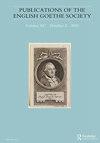Iphigenie auf Tauris, Torquato Tasso, and the Imagery of Character
IF 0.1
3区 文学
0 LITERATURE, GERMAN, DUTCH, SCANDINAVIAN
引用次数: 0
Abstract
ABSTRACT Whether it is in the notion of ‘Bildung’ or the daemonic, the reflective engagement with the self lies at the heart of what makes Goethe compelling for modern readers. This article traces the language and imagery of one notion of self-realization, moral character, in Iphigenie auf Tauris and Torquato Tasso. It identifies recurrent metaphors associated with character in eighteenth and nineteenth century theoretical and popular texts, such as stability, independence, influence, and limitation or focus. It demonstrates how this imagery of character informs the inner logic of the plays, structures the relationships between the individual characters, and how, through it, the dramas can be seen as offering literary reflections on character as a concept. Character emerges as a modern ideal, difficult to achieve yet realistic, worthy of admiration, yet universal.陶、陶与人物意象
无论是在“建设”还是恶魔的概念中,与自我的反思参与都是使歌德对现代读者产生吸引力的核心。本文追溯了《金牛节》和《托夸托·塔索》中一个自我实现的概念——道德品质的语言和意象。它识别了18和19世纪理论和流行文本中与性格相关的反复出现的隐喻,如稳定、独立、影响、限制或集中。它展示了这种人物形象如何影响戏剧的内在逻辑,构建人物之间的关系,以及戏剧如何通过它来提供对人物概念的文学反思。品格作为一种现代理想出现,难以实现却又现实,值得钦佩却又普遍。
本文章由计算机程序翻译,如有差异,请以英文原文为准。
求助全文
约1分钟内获得全文
求助全文
来源期刊

Publications of the English Goethe Society
LITERATURE, GERMAN, DUTCH, SCANDINAVIAN-
CiteScore
0.10
自引率
0.00%
发文量
15
 求助内容:
求助内容: 应助结果提醒方式:
应助结果提醒方式:


